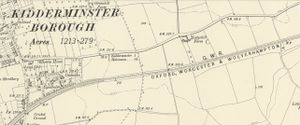Oxford Worcester and Wolverhampton Railway
The Oxford, Worcester and Wolverhampton Railway (OW&W, OWW, or OWWR) was an independent railway company that was formed to build a railway between its three named cities, authorised on 4 August 1845[1]. It began at Wolvercot Junction, near Oxford, from which it ran North-West through Honeybourne and Evesham to Worcester. It then proceeded towards Wolverhampton via Droitwich Spa, Hartlebury, Kidderminster, Stourbridge and Dudley. Due to its overall poor management, the company is sometimes referred to using its derisive nickname, "The Old Worse and Worse".
Contents
History
The company suffered from financial mismanagement early on, and ran out of funds in 1849, before any major part of the line was opened. A protracted legal battle then began as the GWR refused to complete the line (a condition of the Act of Parliament), before realising that its competitors, the Midland Railway and LNWR, were also interested in the line - the GWR finally agreed to lease the line in 1851. The line was eventually completed, still as an independent company, in July 1853, being opened throughout on 1 December 1853[2]. The contractors for the Oxford to Worcester and Tipton to Wolverhampton sections were Peto and Betts who in partnership with Thomas Brassey would later be the contractors for construction of the Severn Valley Railway.
The company's first Locomotive Superintendent, David Joy, was appointed in 1852.[3] He was succeeded in February 1856 by Frederick Hayward.[4]
The company is possibly best known for the Round Oak accident on 23 August 1858, which involved two portions of a special excursion train returning to Wolverhampton. Having been divided into two portions at Stourbridge, a broken coupling on the first portion caused 18 vehicles to run backwards, colliding with the following portion. The collision killed 14 passengers and injured 50 more, and was stated to be the worst railway accident to have ever occured in the UK at that date [5][6].
Links to the Severn Valley Railway
The Severn Valley Railway was proposed to build a line from a junction south of Hartlebury, this later being moved past Hartlebury as a cost-saving measure. The OW&W was heavily involved with the Severn Valley Railway despite nominally being independent companies, with several directors holding positions in both companies, and the OW&W's Engineer John Fowler being appointed as the SVR's engineer in 1855. The OW&W formally agreed to lease the SVR on 14 June 1860, shortly before OW&W merged with the Newport, Abergavenny & Hereford Railway and the Worcester & Hereford Railway, forming the West Midland Railway on 1 July 1860.
Present day
The majority of the original OW&W route remains open, between Oxford and Stourbridge Junction, via Worcester Shrub Hill, Hartlebury and Kidderminster. North of Stourbridge, the line is used for freight services for a short distance, although beyond Round Oak (now the location of the Merry Hill Shopping Centre) it has been variously mothballed or closed and will form part of the Wednesbury to Brierley Hill Metro Extension.[7] Passenger services to Birmingham Snow Hill and beyond continue via the former GWR line which bears to the right a short distance north of Stourbridge Junction.
References
- ↑ Rails In Wolverhampton - The Early Years - The Great Western Railway
- ↑ Wikipedia - Oxford, Worcester and Wolverhampton Railway
- ↑ Boynton (2002) p. 21.
- ↑ Boynton (2002) p. 30.
- ↑ Col. Tyler's report on the Round Oak rail accident
- ↑ Wikipedia - Round Oak rail accident
- ↑ Midland Metro Alliance (Retrieved 13 November 2020)
